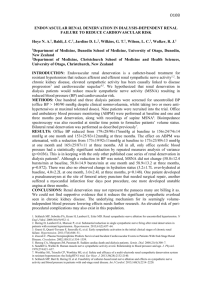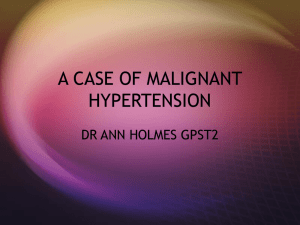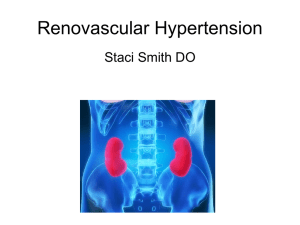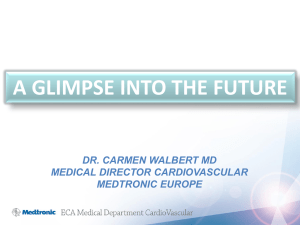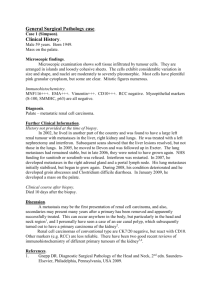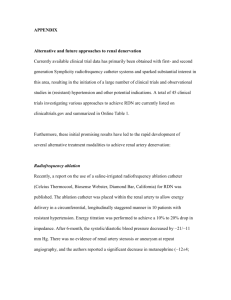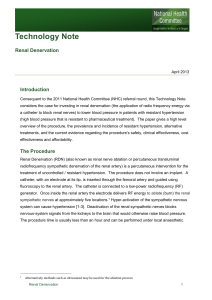Treating Hypertension With Renal Nerve Ablation
advertisement
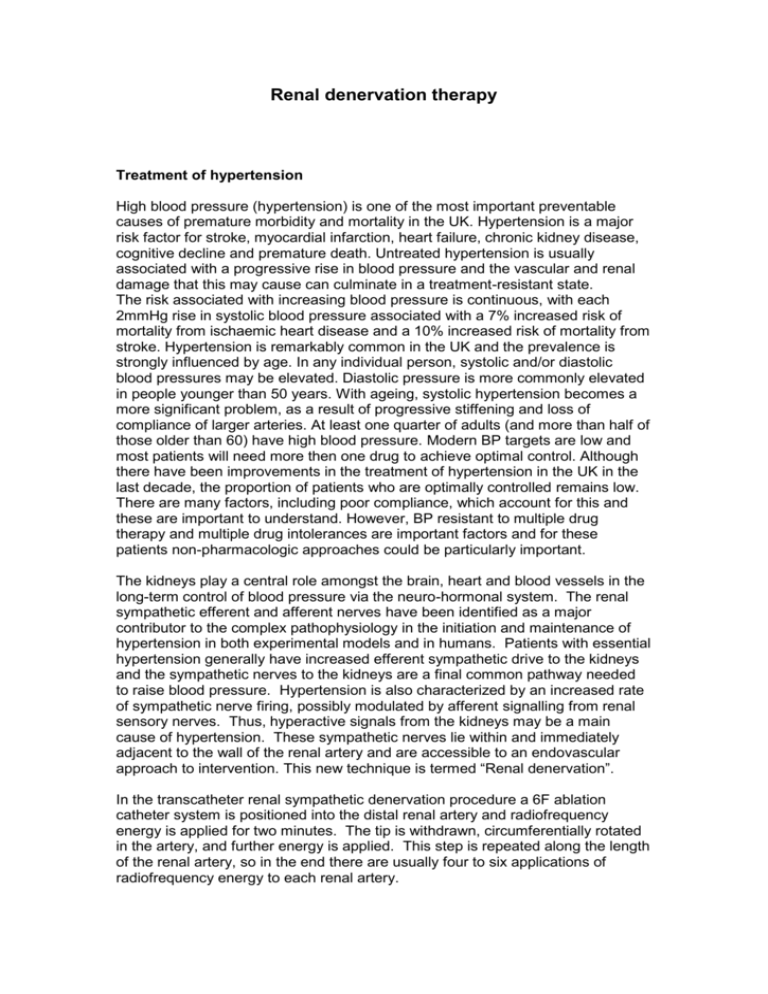
Renal denervation therapy Treatment of hypertension High blood pressure (hypertension) is one of the most important preventable causes of premature morbidity and mortality in the UK. Hypertension is a major risk factor for stroke, myocardial infarction, heart failure, chronic kidney disease, cognitive decline and premature death. Untreated hypertension is usually associated with a progressive rise in blood pressure and the vascular and renal damage that this may cause can culminate in a treatment-resistant state. The risk associated with increasing blood pressure is continuous, with each 2mmHg rise in systolic blood pressure associated with a 7% increased risk of mortality from ischaemic heart disease and a 10% increased risk of mortality from stroke. Hypertension is remarkably common in the UK and the prevalence is strongly influenced by age. In any individual person, systolic and/or diastolic blood pressures may be elevated. Diastolic pressure is more commonly elevated in people younger than 50 years. With ageing, systolic hypertension becomes a more significant problem, as a result of progressive stiffening and loss of compliance of larger arteries. At least one quarter of adults (and more than half of those older than 60) have high blood pressure. Modern BP targets are low and most patients will need more then one drug to achieve optimal control. Although there have been improvements in the treatment of hypertension in the UK in the last decade, the proportion of patients who are optimally controlled remains low. There are many factors, including poor compliance, which account for this and these are important to understand. However, BP resistant to multiple drug therapy and multiple drug intolerances are important factors and for these patients non-pharmacologic approaches could be particularly important. The kidneys play a central role amongst the brain, heart and blood vessels in the long-term control of blood pressure via the neuro-hormonal system. The renal sympathetic efferent and afferent nerves have been identified as a major contributor to the complex pathophysiology in the initiation and maintenance of hypertension in both experimental models and in humans. Patients with essential hypertension generally have increased efferent sympathetic drive to the kidneys and the sympathetic nerves to the kidneys are a final common pathway needed to raise blood pressure. Hypertension is also characterized by an increased rate of sympathetic nerve firing, possibly modulated by afferent signalling from renal sensory nerves. Thus, hyperactive signals from the kidneys may be a main cause of hypertension. These sympathetic nerves lie within and immediately adjacent to the wall of the renal artery and are accessible to an endovascular approach to intervention. This new technique is termed “Renal denervation”. In the transcatheter renal sympathetic denervation procedure a 6F ablation catheter system is positioned into the distal renal artery and radiofrequency energy is applied for two minutes. The tip is withdrawn, circumferentially rotated in the artery, and further energy is applied. This step is repeated along the length of the renal artery, so in the end there are usually four to six applications of radiofrequency energy to each renal artery. Figure: Diagram to show an ablation catheter passed up the descending aorta into the renal artery. Radiofrequency energy is focussed outside the vessel wall in order to denervate the renal afferent and efferent nerves. Renal denervation therapy Procedure Effectiveness An initial pilot study of the procedure in Australia, the Symplicity I trial1, showed promising results. There was an initial 27 mmHg drop in systolic BP and the oneyear followup showed the effect on blood pressure was durable. In Symplicity I 89 percent of of patients had a blood pressure drop. At 12 months, the average decline in systolic blood pressure was 27mmHg and the decrease in diastolic pressure was 13 mmHg. There was no evidence the procedure harmed the renal vessels or kidney function. A follow up randomised controlled study , the Symplicity HTN-2 study2, compared 52 participants who received catheter treatment plus medication with 54 controls who received medication only. Patients were aged 18 to 85 years and had systolic BP of 160 mm Hg or more. At baseline, both groups had nearly identical mean BP (treatment, 178/98 mm Hg vs. control, 178/97 mm Hg). Six-month data showed that BP in the renal denervation group dropped by 32/12 mm Hg (P<.0001), whereas there was no difference in the control group (systolic BP, P=.77; diastolic BP, P=.83). Eightyfour percent of patients undergoing renal denervation had reduced systolic BP of 10 mm Hg or more vs. 35% of controls (P<.0001). There were no changes in renal function with denervation, even in patients with mild to moderate renal failure. The findings suggest that the procedure itself and associated haemodynamic changes have no short term adverse renal effects. On the basis of there trials the Symplicity Catheter System has CE mark approval in Europe and is available for clinical use. However, what must be emphasised is that there are limited data on the device. Ambulatory BP monitoring in the Symplicity HTN-2 study, while still showing a difference in the catheter treated and control groups, did not suggest as large a difference as the clinic BP differences. This finding is hard to explain. More importantly, although there have not been major complications reported to date with the procedure, the safety data is confined to these small patient groups and long term, follow up data is not yet available. Despite these reservations, the procedure is very exciting in that it offers treatment of BP and significant reduction of the risk of cardiovascular morbidity and mortality in patients with resistant hypertension.

